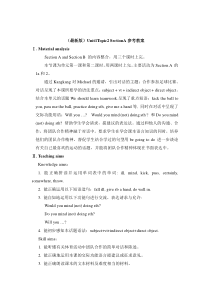 DOC
DOC
【文档说明】Unit 1 Topic 2《I’ll kick you the ball again》(SectionA)教案-八年级上册英语【仁爱版】.doc,共(8)页,53.000 KB,由小喜鸽上传
转载请保留链接:https://www.ichengzhen.cn/view-104229.html
以下为本文档部分文字说明:
(最新版)Unit1Topic2SectionA参考教案Ⅰ.MaterialanalysisSectionAandSectionB的内容整合,用三个课时上完。本节课为单元第一课和第二课时,用两课时上完。主要活动为SectionA的1a和2。通过Kangkang对Michael的邀请,引出对话的主题
:合作参加足球比赛。对话呈现了本课所要学的语法重点:subject+vt+indirectobject+directobject。结合本单元的话题Weshouldlearnteamwork.呈现了重点短语:kicktheballtoyou,passmetheball,practiced
oingsth,givemeahand等,同时在对话中呈现了交际功能用语:Willyou…?Wouldyoumind(not)doingsth?和Doyoumind(not)doingsth?帮助学生学会请求,提建议的
表达法。通过和他人的沟通、合作,将团队合作精神融于对话中。要求学生在学会课本语言知识的同时,培养他们的团队合作精神。督促学生结合学过的句型用begoingtodo进一步谈论有关自己最喜欢的运动的话题,并能将团队合作精神体现在书面表达中。Ⅱ.TeachingaimsKnowledgeaims:1.能
正确拼读并运用单词表中的单词:ill,mind,kick,pass,certainly,somewhere,throw.2.能正确运用以下短语造句:fallill,givesbahand,dowellin.3.能自如地运用以下功能句进行交流,表达请求与允许:Wouldyoumind(not)
doingsth?Doyoumind(not)doingsth?Willyou…?4.能初步感知本话题语法:subject+vt+indirectobject+directobject.Skillaims:1.能听懂有关体育活动中团队合作的简单对话和陈述。2.能正确地运用本课的
交际功能语言提建议或征求意见。3.能正确朗读课本的文本材料及难度相当的材料。4.能写出自己最喜欢的运动,并能正确地运用本课双宾语的语法结构,写出简单的团队合作的过程。Emotionalaims:通过对Secti
onA的学习,学生能够将团队精神渗透到自己的书面表达中,丰富对自己最喜欢的运动的描写。同时,强化学生积极参与运动的意识,逐渐将团队合作精神渗透到学生的学习和生活中。Ⅲ.ThekeypointsanddifficultpointsKeypoints:能自如地运用以下功能句进行交流:Wo
uldyoumind(not)doingsth?Doyoumind(not)doingsth?Willyou…?Difficultpoints:1.双宾语:subject+vt+indirectobject+directobject.
2.1c活动中近义句的转换。Ⅳ.Learningstrategies1.通过学习近义句的转换,使学生有能力对同一句话进行不同的表达。2.通过学生看图听音的训练,鼓励学生大胆预测所学内容。Ⅴ.TeachingaidsComputermultimediaprojec
tor,ashortvideoofaping-ponggameEverydaysaying:There’sno“I”inteamwork.全队的配合不分你我。Ⅵ.TeachingproceduresStepInteractionpatternStude
ntactivityTeacheractivityIntroduction(5minutes)1.Thewholeclasswork2.Thewholeclasswork3.Twostudents’work4.T
hewholeclasswork5.Somestudents’work6.Groupwork1.Focustheirattentionontheteacher.2.Readthesayingaloud.3.Agirlandaboyreport,introducingtheirweekendp
lan.4.Studentswatchthevideo.5.Studentsgivesomeexamples:(1)Discussingroups.(2)Playfootball.6.Students
discussingroupsandtrytoanswertheteacher’squestions:(1)S1:Heisill.S2:Heissleeping.(2)S3:Maybetheyaret
alkingaboutafootballgame.(3)S4:MaybeheisKangkang’sfriendorMichael’sfriend.1.Greetstudentsreadyforlearning.2.
Showeverydaysayingforthestudents.(onesayingaweek)3.Askagirlandaboytogivetheeverydayreport:Myweekendplan.4.Teacherpla
ysthevideoofplayingtabletennistointroducethetopic“Weshouldlearnteamwork”.5.Teacherasksstudentswhenandwhereweneedteamwork.6.
Teachershowsthepicturesof1aonthescreen,lettingthestudentsguess:(1)What’swrongwiththeboyinbed?(2)WhatisKangkangtalkingtoMichael?(3)Whoist
hesleepingboy?Presentation(10minutes)1.Thewholeclasswork2.Thewholeclasswork3.Thewholeclasswork4.Thewholeclasswork5.Somestudents’work6.The
wholeclasswork7.Thewholeclasswork1.Studentsmakesurethattheyunderstandwhatthestatementsmean.2.Studentstrytocatchthegenera
lideaofthedialogueandfillintheblanks.3.Studentswritedownthekeys,payingattentiontothecauses.4.Studentscompletetheblankstheyh
aven’tfinished.5.Volunteerswriteanswersto1bontheblackboard.6.Studentsanswerthethreequestionstogether:(1)Hefellill/wasill.(2)Theyaretalkinga
boutthefootballgameonSaturday.(3)HeisoneofKangkang’steammates.7.Studentssaytogether:Wouldyoumindrowing/cycling/skating/playingtennis/swimmingwit
hme?1.Finish1b.Teacherasksthestudentstoreadthestatementsin1b.2.Teacherplaystherecordingforthefirsttimewithoutstopping.3.Teacherplays
1aforthesecondtime,andstopswhennecessary.4.Teacherletsstudentsscan1aandcomplete1b.5.Teacheraskstwostudentstowriteanswersto1b,an
dthenhelpstocorrectthewrongparts.6.Teacherchecksthepre-readingquestionstoseeifstudentshaveguessedcorrectly:(1)What’swr
ongwiththeboyinbed?(2)WhatisKangkangtalkingtoMichael?(3)Whoisthesleepingboy?7.Focusonpracticing“Wouldyouminddoing…withme?”Teachershowssom
everbphrasesonthescreenforthestudentssothattheycanpracticereplacingwiththosephrases:rowing,cycling,skating,Consolidation(10minutes)
1.Thewholeclasswork2.Thewholeclasswork3.Groupwork4.Thewholeclasswork5.Thewholeclasswork6.Somestudents’work7.Thewholeclasswork1.Studentstrytounders
tandtheexplanationofthephrases.2.Studentsread1c,understandingwhattheyshoulddo,andthenfinish1c.3.Studentscandiscussingroupsan
dvolunteerswritetheanswersontheblackboard.4.Studentsknowdirectobjectandindirectobjectafterlistening.5.Studentsunderlinethesenten
cesandrewritethem.6.Volunteersreadtheanswers.7.Studentsunderlineintheirbooksandmakesomenotes.1.Teacherexplainsthephrasesinboxbyusingsynon
ymousphrases.2.Teachergivestwoorthreeminutesforthestudentstofinish1c.3.Teacheraskstwoorthreestudentstowritetheiranswersontheblackboar
d.4.Teacherexplainsthestructureof“thesubject+vt+indrectobject+directobject”inChinese,showingafewexamples.5.Teacherasksthestu
dentstofinish1d.6.Teachercheckstheanswers.7.Teacherexplainssomekeypointsanddifficultpointstothestudents:(1)Thestructureof“thesubject+vt+indrectob
ject+directobject”(2)Thesynonymousphrases:fallill/beill(3)oneof+pluralnouns(4)minddoingsth(5)keepdoingsthPractice(10minutes)1.T
hewholeclasswork2.Thewholeclasswork3.Thewholeclasswork4.Groupworkandindividualwork5.Groupwork1.Studentslookatthepictu
resandsaysomephrases:thehighjump,playbasketball,playfootball,litterthings.2.StudentslistenandfinishAin2first.3.Studentswritedowntheanswer
sintheirbooks.4.StudentschecktheiranswerstoBin2.Theymaydiscussingroups.5.Fourstudentsfromthesamegroupwritetheanswersontheblackboard.Eac
hstudentwritesoneanswer.1.Teacherencouragesthestudentstolookatthepicturesin2andguesswhat’shappening.2.Teacher
playstherecording.3.Teacherplaystherecordingandpausesaftereachdialogue.4.Teacherplaystherecordingfor
thethirdtime.5.Teacherchecksthestudents’answers,askingagrouptoshowtheiranswersontheblackboard.Teachercorrectsthewrongparts.Production(8minu
tes)1.Thewholeclassworkandpairwork2.Thewholeclassworkandpairwork3.Thewholeclasswork4.Thewholeclasswork5.Indi
vidualwork1.Studentspracticethedialoguebyreplacingthefollowingphrasesandaskandanswerinpairs:kickingtheballtome;k
ickingmetheball.showingthebooktome;showingmethebook.givingthebooktome;givingmethebook.2.Studentspracticeinpairsinthesame
way:shoutingaloud;cominghometoolate;coloringthewall;drinkingtoomuch;crossingthestreetwhenthetrafficlightsare
red.3.Studentspractice2inpairstomakesurethattheycanreadthedialoguefluently.4.StudentssummarizeSectionAwiththeteacherby
doingexercisesshownonthescreen.5.Studentsdohomeworkafterclass:(1)Memorizethesummaryafterclass.(2)Studentswritedownthe1.Teacher
organizesthestudentstopracticethedialoguein2inpairs,helpingstudentstolearnthewaystoexpresspermissionandgivingadvice.—Wouldy
oumindpassingmetheball?—Ofcoursenot.I’lldoitrightaway.2.TeachershowsthedialogueFourontheblackboard,lettingstud
entsdopairwork.—Wouldyoumindnotthrowingbottlesaround?—I’msorryaboutthat.Iwon’tdoitagain.3.Teacherasksthestudentstopractice2inpairsinthe
irowngroupstoprepareforaspeedcompetition.4.Teachershowsthesummarytothestudents.5.Teacherassignshomework:(1)Reviewthesummaryafte
rclass.(2)Retell1aandreportittothewholeclasstomorrow.(3)PrepareSectionBafterclass.TeachingReflectionIt’sh
ardforthestudentstousethestructureof“subject+vt+indirectobject+directobject”freely.It’salsohardforthestudentstoparaphrasethesynonymoussentences.
Teachershoulddesignmorerelevantexercisesforthestudents.Ⅶ.BlackboarddesignUnit1PlayingSportsTopic2Weshouldlearnteamwork.Secti
onAWouldyoumind(not)doingsth?fallill/beillDoyoumind(not)doingsth?begoodat/dowellinkicktheballtome=kickmetheballWouldyoumind…
?givemeahandCouldyou…please?
 辽公网安备 21102102000191号
辽公网安备 21102102000191号
 营业执照
营业执照